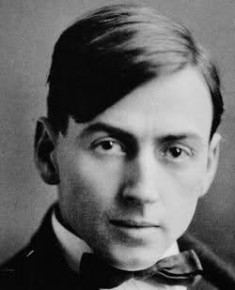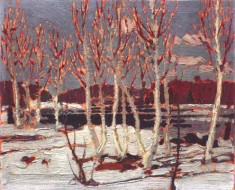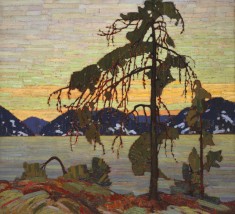| Tom Thomson | |
|---|---|
 |
|
| Born | Thomas John Thomson Aug. 5, 1877 Claremont, Ontario |
| Died | July 8, 1917 (at age 39) Canoe Lake, Algonquin Park, Ontario |
| Nationality | Canadian |
| Movement | Canadian Art |
| Field | Painting |
| Works | |
Tom Thomson (1877-1917) is a late 20th Century artist from Canada who influenced a circle of young Canadian artists which was later called the Group of Seven. Although he passed away before the group was actually formed, there are some who mistakenly think that he was the one responsible for getting the group together or was a part of the group. Thomson died under unknown circumstances, which many have found to add to his overall mystique as an artist.
Thomson’s Early Life
Thomson was born and raised near Ontario, Canada. In 1899, he worked in a machine shop as an apprentice to a man named William Kennedy, who was a good friend of his father. However, he was soon fired from his job because of repeated tardiness.
Later that year, Thomson signed up for the 2nd Boer War, but was refused for an unknown medical condition. This was the same reason he was refused entry for service in the First World War as part of the Canadian Expeditionary Force. He later entered a business school which was located in Chatham, Ontario, but later dropped out after only a couple of months.
He then joined his brother who was running a business school in Seattle. This was where he had a short summer romance with the American romance novelist Alice Elinor Lambert.
Thomson’s Artistic Beginnings
In 1904, Thomson returned to Ontario. It was then that he may have studied with William Cruikshank, a well-known artist of the time. A couple years later, he joined Grip Ltd., a design firm based in Toronto. Many of the Group of Seven members later worked in this firm as well.
Algonquin Park was a major influence to Thomson. In fact, this is where he said he got the inspiration for many of his works. He first visited the park in 1912 along with some of his workmates. They would travel around the Ontario region and send a lot of time in the wilderness, too. In 1913, he exhibited with the Ontario Society of Artists. He became a member a year later when the National Gallery of Canada took an interest and bought one of his paintings. He would continue to exhibit his work with the Ontario Society of Artists until his death.
Thomson’s Art and Technique
 Thomson mostly taught himself about art and techniques. He learned many of his skills while he worked as a graphic artist at Grip Ltd. Although he painted quite often as a child and did enjoy art, he did not take painting seriously until he was in his mid-30s.
Thomson mostly taught himself about art and techniques. He learned many of his skills while he worked as a graphic artist at Grip Ltd. Although he painted quite often as a child and did enjoy art, he did not take painting seriously until he was in his mid-30s.
The scenery at Algonquin Park first inspired him to follow after his workmates to start sketching and painting. They used oil on small rectangular pieces of paper for easy portability when hiking or traveling. Between 1912 and his accidental death in 1917, he created many of these small sketches. These are considered works of art in their own rights and are now exhibited in many galleries throughout Canada.
A lot of Thomson’s paintings were first small sketches before they were expanded into bigger oil paintings. He worked on these in his studio, which was a small cabin at Rosedale, Ontario. It was through the help of a Canadian physician named James MacCallum that Thomson was able to begin his transition from a small-time graphic designer into a renowned painter.
Thomson’s Success
 Although Thomson only sold a few of his works during his lifetime, one was exhibited posthumously in Wembley, London, which garnered international attention for him. Some of his more popular pieces include The Jack Pine, Forest Undergrowth, and April in Algonquin Park, just to name a few.
Although Thomson only sold a few of his works during his lifetime, one was exhibited posthumously in Wembley, London, which garnered international attention for him. Some of his more popular pieces include The Jack Pine, Forest Undergrowth, and April in Algonquin Park, just to name a few.
The Algonquin School, otherwise known as the Group of Seven, did not form until Thomson had passed away, yet the artists within the group shared the same style of painting as Thomson. They had a fascination with rugged and unkempt scenery. They all used very broad brush strokes and bright colors to capture the vibrant beauty of Canadian landscapes.
Thomson’s Death and Legacy
Thomson died on July 8, 1917, during a hiking and canoeing trip in Algonquin Park. His body was found floating offshore eight days later. The official report of his death said it was an accidental drowning. However, there are different theories and questions about how Thomson actually died.
In September 1917, several artists along with some area residents put up a memorial monument at the location where Thomson had died. Since his death, the artist’s work has increased in popularity. In 2002, the National Gallery of Canada held an exhibit for his work. They regarded him as a great Canadian artist with the same level of prominence as the likes of Picasso. Throughout the years and after his work gained popularity, many forgeries of his paintings have been found.